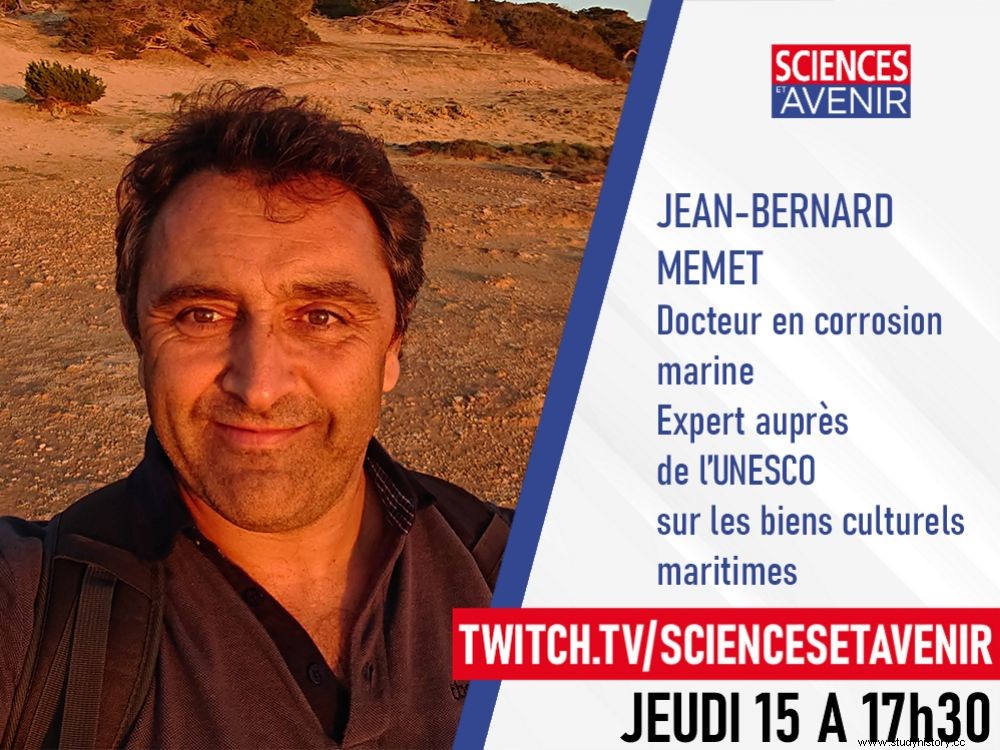Ancient boats, corsair galleons or ships from the 2nd World War:from the depths of the waters where they lie, how to study wrecks? And keep them? Response on Twitch with 1h30 live with marine corrosion expert Jean-Bernard Memet. Watch it in replay on the Sciences et Avenir website.

Jean-Bernard Memet, guest of the Sciences et Avenir Twitch channel on April 15, 2021 at 5:30 p.m.
"Rustologist". Understand rust expert. This is how Jean-Bernard Memet willingly defines himself. A somewhat hasty neologism for this doctor in marine corrosion, conservation-restoration expert with UNESCO and co-editor of the appendix to the International Charter of Maritime Cultural Heritage. Thursday April 15, 2021, at 5:30 p.m., he was the guest of the Twitch channel of Sciences et Avenir (twitch.tv/sciencesetavenir) for 1h30 of live during which we explored 2000 years of underwater wrecks - finally, we did our best on stream time , visible below in replay!
From ancient Rome to the time of the corsairs
Jean-Bernard Memet has indeed worked on many wrecks, some of which date back to antiquity. Thus, we have mentioned the case of the barge Arles Rhône 3, which dates from Roman times, and whose recovery was the subject of a construction site of all records:it was necessary to take out of the water 10 tons of wood, to the fragility of glass, which visitors to the Arles Antique departmental museum can now admire... outside of periods of confinement.
The April 15, 2021 stream. Sciences et Avenir and Jean-Bernard Memet would like to thank photographer Teddy Séguin and the DRASSM (Department of Underwater and Underwater Archaeological Research) who gave permission to use during this live the documents shown there.
The "rustologist" also intervened on two corsair wrecks, discovered in 1995 off Saint-Malo:the Dauphine, sunk in 1704, and the Aimable Grenot, sunk in 1749, two boats which, underwater, were stacked one over the other ! Closer to us in time, there is also the case of the Hunley submarine, found off Charleston, South Carolina, USA. "This is the first submarine in the history of mankind that sank a ship, it was in 1848, explains Jean-Bernard Memet.And he himself sank on his way back! The 8 bodies of the crew members were found there who, in the closed environment of the submarine, had remained locked up there".
We must save the wrecks
The scientist, also co-founder of the company A-Corros, based in Arles, also mentioned the various programs now dedicated to the preservation of wrecks. Thus, A-Corros is currently involved with the DRASSM (Department of Underwater and Underwater Archaeological Research), the Laboratory of Archaeological Materials and Weathering Prediction of the CEA of Saclay and the University of Pau and Pays de l 'Adour on the "SOS wreck" program. "We have created a citizen science network, the wreck sentinel network, which mainly concerns recreational wreck divers, explains Jean-Bernard Memet. On the two wrecks of the SOS program, we installed metal coupons - with and without cathodic protection (whose use is explained in this stream, editor's note) - and we expect, through this network of sentinels, that divers send us photos of these coupons if they miss them while diving via the email address [email protected]" . If you have your fins and a good camera, you have been warned.
